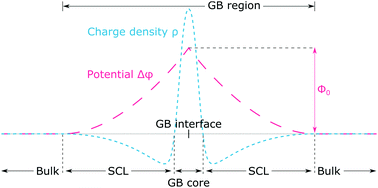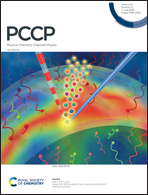Assessing common approximations in space charge modelling to estimate the proton resistance across grain boundaries in Y-doped BaZrO3
Abstract
We apply density functional theory to estimate the energetics and charge carrier concentrations and, in turn, the resistance across the (210)[001] and (111)[1![[1 with combining macron]](https://www.rsc.org/images/entities/char_0031_0304.gif) 0] grain boundaries (GBs) in proton conducting Y-doped BaZrO3, assessing four commonly used approximations in space charge modelling. The abrupt core approximation, which models the GB core as a single atomic plane rather than a set of multiple atomic planes, gives an underestimation of the GB resistance with around one order of magnitude for both GBs. The full depletion approximation, which assumes full depletion of effectively positive charge carriers in the space charge layers, has negligible effect on the GB resistance compared to a more accurate model with decaying depletion. Letting protons redistribute in the continuity between atomic planes gives a GB resistance up to 5 times higher than the case where protons are restricted to be located at atomic planes. Finally, neglecting trapping effects between the acceptor doping and the defect charge carriers gives a higher GB resistance with a factor of roughly 2.
0] grain boundaries (GBs) in proton conducting Y-doped BaZrO3, assessing four commonly used approximations in space charge modelling. The abrupt core approximation, which models the GB core as a single atomic plane rather than a set of multiple atomic planes, gives an underestimation of the GB resistance with around one order of magnitude for both GBs. The full depletion approximation, which assumes full depletion of effectively positive charge carriers in the space charge layers, has negligible effect on the GB resistance compared to a more accurate model with decaying depletion. Letting protons redistribute in the continuity between atomic planes gives a GB resistance up to 5 times higher than the case where protons are restricted to be located at atomic planes. Finally, neglecting trapping effects between the acceptor doping and the defect charge carriers gives a higher GB resistance with a factor of roughly 2.

- This article is part of the themed collection: 2020 PCCP HOT Articles


 Please wait while we load your content...
Please wait while we load your content...